
Aporia crataegi, the black-veined white, is a large butterfly of the family Pieridae. A. crataegi is widespread and common. Its range extends from northwest Africa in the west to Transcaucasia and across the Palearctic to Siberia and Japan in the east. In the south, it is found in Turkey, Cyprus, Israel, Lebanon and Syria. It is not usually present in the British Isles or northern Scandinavia.
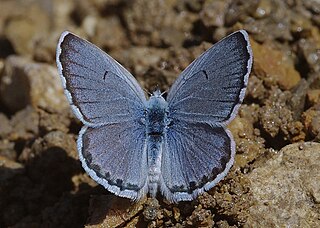
Pseudophilotes vicrama, the eastern baton blue, is a small butterfly found in Asia, east to Tian Shan and parts of China, west to the Balkans, Turkey, eastern Europe to southern Finland. It belongs to the lycaenids or blues family. The species was first described by Frederic Moore in 1865.
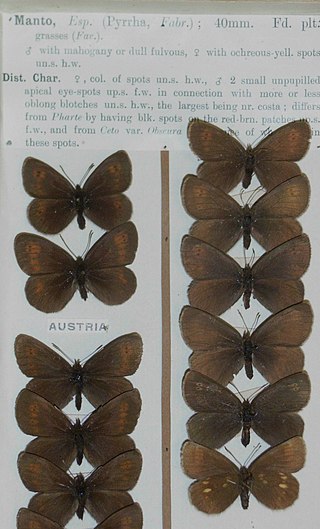
The yellow-spotted ringlet is a member of the subfamily Satyrinae of the family Nymphalidae. It is associated with (sub)alpine meadows at 900–2,500 m above sea level. It is found in the Alps, the Pyrenees, the Cantabrian Mountains, the Massif Central, the Vosges Mountains, the Carpathian Mountains and the mountains of Herzegovina.

The bright eyed ringlet is a member of the Satyridae subfamily of Nymphalidae. It is a high mountain butterfly found in the Pyrenees, Massif Central, Alps and Balkan mountains. It has recently been confirmed to occur in the southern chain of the Carpathians.

Chazara briseis, the hermit, is a butterfly species belonging to the family Nymphalidae. It can be found in North Africa, southern Europe, Asia Minor, the Caucasus, Kazakhstan, Central Asia through Afghanistan, and north-western China and Tuva. It is found on steppe and in other dry grassy places between 500 and 2,500 meters.

Erebia pandrose, the dewy ringlet, is a member of the subfamily Satyrinae of the family Nymphalidae. It is found from the Arctic areas of northern Europe, the Pyrenees, Alps, the Apennine Mountains, the Carpathian Mountains, Kola Peninsula and Kanin Peninsula, part of the Ural and the Altai and Sayan Mountains up to Mongolia.

Melanargia russiae, or Esper's marbled white, is a butterfly in the family Nymphalidae. It is found in Spain, Portugal, south-eastern France, Italy, the Balkans, southern Russia, the Caucasus and western Siberia.

Pseudochazara anthelea is a species of butterfly in the family Nymphalidae. It is found in Albania, the Republic of Macedonia, Bulgaria, Greece, Turkey and northern Iraq. The males can be easily distinguished from the females by the white base and they are found in dry, stony slopes and gullies, usually on limestone.

The twin-spot fritillary is a butterfly in the family Nymphalidae.

Melitaea arduinna, or Freyer's fritillary, is a butterfly of the family Nymphalidae. It is found from south-eastern Europe across Asia Minor to central Asia and the Altai. The habitat consists of steppe-clad slopes.

Pieris krueperi, the Krueper's small white, is a butterfly in the family Pieridae. It is found on the Balkan Peninsula and in Iran, Baluchistan, the Kopet-Dagh and from Asia Minor to Central Asia, as well as in Oman. The habitat consists arid areas with scanty vegetation up to 2,500 metres (8,200 ft) in the mountains.
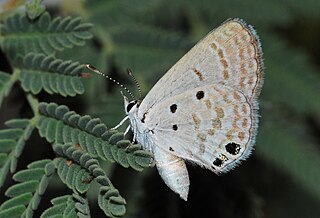
Luthrodes galba, the Persian grass blue, is a butterfly in the family Lycaenidae. It is found in southern Turkey, central and eastern Arabia, Iraq, Iran, Afghanistan, the Caucasus and Cyprus.
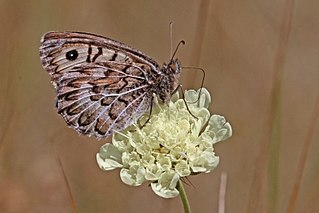
Pseudochazara geyeri, the Grey Asian grayling is a species of butterfly in the family Nymphalidae. It is confined to Albania, Greece, North Macedonia, eastern Turkey and south-western Transcaucasia.

Pseudochazara hippolyte is a species of butterfly in the family Nymphalidae. It is confined from the southern Urals across Kazakhstan and northern Tian-Shan to Transbaikalia, Mongolia and northern Tibet.
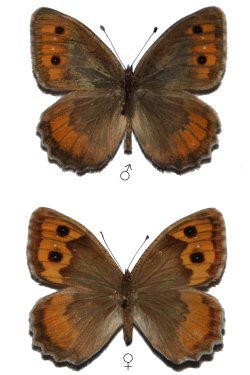
Pseudochazara mniszechii, the tawny rockbrown, is a species of butterfly in the family Nymphalidae. It is confined to Greece, Turkey, northern Iran, Balochistan, and the Caucasus.

Pseudochazara pelopea is a species of butterfly in the family Nymphalidae. It is confined to Lebanon, Turkey, the Caucasus, Syria, Turkmenistan and Kopet-Dagh.

Arethusana is a butterfly genus from the subfamily Satyrinae of the brush-footed butterfly family (Nymphalidae). It is composed of only one species, Arethusana arethusa, the false grayling.

Tomares nogelii is a small butterfly found in the Palearctic that belongs to the blues family.
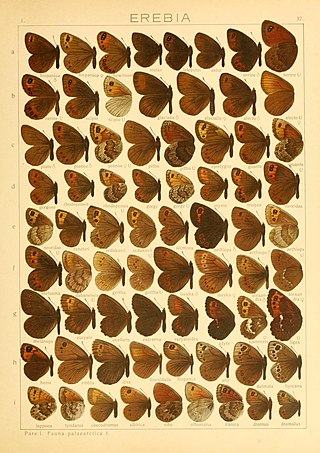
Proterebia afra is a small butterfly found in the Palearctic that belongs to the browns family.

Gonepteryx farinosa , the Powdered Brimstone, is a butterfly found in the Palearctic that belongs to the whites family.




















